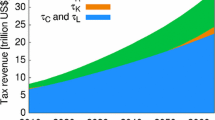Abstract
This paper finds that optimal international carbon taxes are country specific and we can decompose a tax on a domestically produced carbon-intensive commodity into a revenue tax, a tax to control local atmospheric pollution and an international carbon tax. It shows that an institutional arrangement for the world economy similar to the fiscal federalism in the federal countries can be useful to internalize the global externalities of atmospheric pollution.
Similar content being viewed by others
References
Atkinson, A. B. and J. E. Stiglitz (1980), Lectures on Public Economics, MaGraw-Hill, New York.
Baumol, W. J. (1972), ‘On Taxation and the Control of Externalities’, American Economic Review 62, 307–322.
Diamond, P. A. and J. A. Mirrlees (1971), ‘Optimal Taxation and Public Production, I and II’, American Economic Review 61, 8–27 and 261–278.
Dornbusch, R. and J. Poterba, eds. (1991), Economic Policy Response to Global Warming, forthcoming.
Hoel, M. (1990), ‘Efficient International Agreements for Reducing Emissions of CO2’, Department of Economics, University of Oslo, Mimeo No. 6.
Hoel, M. (1991), ‘Global Environmental Problems: The Effects of Unilateral Actions Taken by One Country’, Journal of Environmental Economics and Management 20, 55–70.
Hoel, M. (1992), ‘Carbon Taxes: An International Tax or Harmonized Domestic Taxes?’, European Economic Review 36, 400–406.
Murty, M. N. and P. B. Nayak (1982), ‘Externality Abatement Technologies, Pigouvian Taxes and Property Rights’, Indian Economic Review 17, 1–26.
Murty, M. N. and P. B. Nayak (1993), A Normative Approach to Resource Transfers’, in A. Bagchi and N. Stern, eds., Tax Policy and Planning in Developing Countries, India: Oxford University Press.
Murty, M. N. and R. Ray (1990a), ‘Optimal Taxation and Resource Transfers in a Federal State’, Department of Economics, Delhi School of Economics, Working Paper No. 90/01.
Murty, M. N. and R. Ray (1990b), ‘Fiscal Federalism and Optimal Commodity Taxation: A Comparison and Centralized and Decentralized Decisions,’, Working Paper No. E/147/90, Institute of Economic Growth, Delhi.
Oates, W. E. (1990), ‘Public Finance with Several Levels of Government: Theories and Reflections’, paper presented at 46th Congress, International Institute of Public Finance, Brussels, 27–30, August.
Pearce, D. (1991), ‘The Role of Carbon Taxes in Adjusting to Global Warming’, Economic Journal 101, 938–948.
Poterba, J. (1991), ‘Designing a Carbon Tax’, in Dornbusch and Poterba (1991).
Rio (1992), The United Nations Conference on Environment and Development.
Sandmo, A. (1975), ‘Optimal Taxation in the Presence of Externalities’, Swedish Journal of Economics 77, 86–98.
Schelling, T. C. (1991), ‘International Burden Sharing and Co-operation: Prospects for Cooperative Approaches to Global Warming’, in Dornbusch and Poterba (1991).
Schelling, T. C. (1992), ‘Some Economics of Global Warming’, American Economic Review, March, 1–14.
Author information
Authors and Affiliations
Rights and permissions
About this article
Cite this article
Murty, M.N. Fiscal federalism approach for controlling global environmental pollution. Environmental and Resource Economics 8, 449–459 (1996). https://doi.org/10.1007/BF00357413
Accepted:
Issue Date:
DOI: https://doi.org/10.1007/BF00357413




